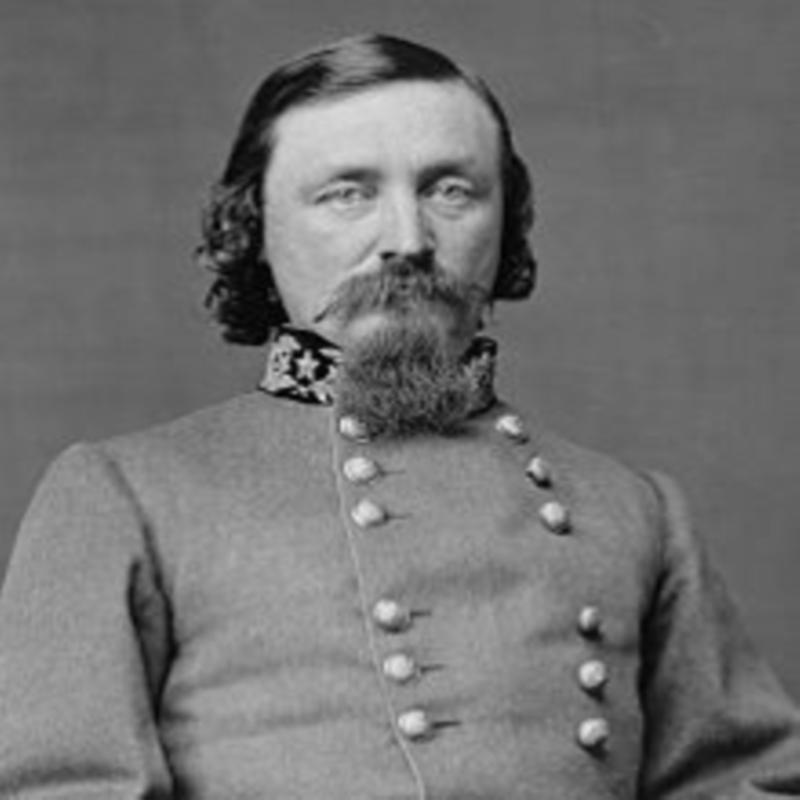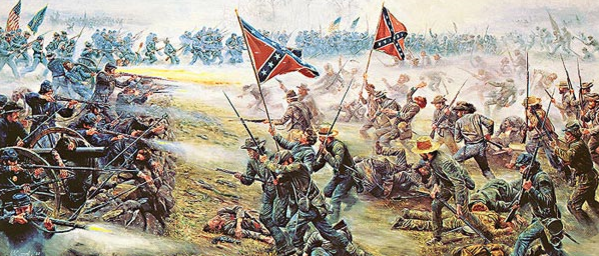Witnessing Pickett's Charge
Posted on 8th January 2021
At 2pm on 3 July 1863, after two days of bitter fighting in and around the small town of Gettysburg in Pennsylvania, some 13,000 Confederate troops left their positions on Seminary Ridge to advance almost a mile over open ground and in intense heat to assault the centre of the Union line.
General Robert E Lee intended it to be the decisive blow in a battle he appeared close to winning but the assault known to history by the name of the flamboyant Commander of the Virginia Brigade General George E Pickett (below) as ‘Pickett’s Charge’ would be repulsed and fail in its objectives. But inaction on the part of the Union’s General George Meade to fully exploit the situation meant it was not quite the decisive turning point in the war as first appeared.
But it has since become a by-word for folly, sacrifice and courage.
Below are accounts of the charge by both participants and observers, of the fighting itself and its aftermath:

(Colonel Edward Porter Alexander, Commander of Confederate Artillery): Pickett’s Division swept out of the wood and showed the full length of its gray ranks and shining bayonets, as grand a sight as any man ever looked upon.
Jesse Bowman Young, who as a young Lieutenant in the Union Army fought at Gettysburg and later provided a narrative account of events, described the scene: Standing on the hill where the Union troops are posted, let us try to picture that almost matchless moment. A stone fence is immediately in our front, with batteries of artillery lining the slope. Here are bronzed and worn veterans in blue, with a set and dogged expression on their lips and in their eyes, line after line of them, massed on both slopes of Cemetery Ridge and on its crest in support of the batteries. In front, toward the west, is the advanced line of the Union troops, beyond them pleasant fields rolling in beauty. The fences are mostly broken down. The Emmitsburg Road crosses the landscape toward the south-west and a mile away toward the region of the setting sun is Seminary Ridge crested with woods and orchards.
Over this plain, against these batteries and upon this, stone wall more than 10,000 men are about to be led with a furious and indomitable courage not to be paralleled by any other martial achievement hitherto wrought by the Army of Northern Virginia.
As we look, with bated breath and quivering nerves on the landscape, we behold the shimmer and steel along the distant ridge, and then the flutter of banners, and then an advancing line of men.
Lieutenant Edmund Rice (Union Army): A line of Confederate skirmishers sprang lightly forward and moved rapidly down into the open fields, closely followed by a line of battle, then by another, and by yet a third, almost a mile in length. Both sides watched this never-to-be-forgotten scene the grandeur of an attack by so many thousands of men. Gibbon’s Division which was to stand the brunt of the assault looked with admiration on the different lines of Confederates marching forward with easy swinging step, and our men were heard to exclaim “ Here they come! Here they come!
Lieutenant G W Finley (Army of Northern Virginia, Pickett’s Division): Where I marched through a wheat field that sloped gently toward the Emmitsburg Road, the position of the Federals flashed into view. Skirmishers lined the fences along the road, and back of them, along a low stone wall or fence, gleamed the muskets of the first line. In rear of this, artillery, thickly planted, frowned down upon us.
As we came in sight there appeared to be a restlessness and excitement along the enemy lines, which encouraged some of us to think they would not make a stubborn resistance. Their skirmishers began to run in, and the artillery, opened upon us all along our front. I also noticed that shells were coming from our right. I discovered it was coming from the Round Tops and whenever it struck our ranks it was fearfully destructive. One Company a little to my right, numbering thirty-five to forty men, was almost swept to a man, from the line by a single shell. We had not advanced far beyond our own guns when our gallant Colonel Stuart fell mortally wounded.
General Carl Schurz (Army of the Potomac): The alignment was perfect. The Battle Flags fluttered gaily over the bayonets glittering in the sunlight. Through our field glasses we could distinctly see the gaps torn in their ranks and the ground dotted with the dark spots of their dead and wounded. Now and then a cheer went up from our lines when our men saw some of our shells striking right among the advancing enemy and scattering death and destruction around. But the brave rebels promptly filled the gaps from behind or by closing up on their colors; and unshaken and unhesitating they continued their onward march.
Lieutenant G W Finley (Army of Northern Virginia, Pickett’s Division): Steadily on with the artillery fire growing ever more furious and deadly our men advanced. As we neared the Emmitsburg Road, the Federals behind the stone wall on Cemetery Ridge opened a rapid musket fire upon us and men were falling all around. Cannon and muskets were raining death upon us. Still on and up the slope toward that stone wall our men steadily swept. When we were about seventy-five or one hundred yards from the stone wall some of the men holding it began to break for the rear, without orders our lines our line poured a volley or two into them, and then rushed upon the wall.
Just as I stepped upon the stone wall I noticed for the first time a line of troops just joining upon our left. They were from Archer’s Tennessee Brigade, this gallant Brigade had been terribly cut-up in the first days fight, and there was but a fragment of them left. Some of them with us seized and held the stone wall in front of us. For several minutes there were no enemy immediately in front of us but to our left the Federal line was still unbroken. This fact was impressed upon my mind from by our brave General Garnet riding to our left with his eyes fastened upon the unbroken line behind the stone wall with the evident intention of making such a disposition of his men as to dislodge them. At that instant, suddenly a terrific fire burst upon us from our front, and, looking around I saw a fresh line of Federals trying to force us from the stone wall, but after exchanging a few rounds with them they fell back leaving us still in possession of the stone wall.
Under this fire I immediately learned that General Garnet had fallen dead. Almost simultaneously General Armistead, on foot, strode over the stone wall, leading his Brigade most gallantly, with his hat on his sword, and calling upon his men to charge. A few of us followed him until, just as he put his hand upon one of the abandoned guns, he was shot down.

Charles Carleton Coffin (Journalist with the Army of the Potomac): There are bayonet thrusts, sabre strokes, pistol shots . . . hand-to-hand contests; the recklessness of life, determination of purpose; oaths, yells, curses, hurrahs; men going down on their hands and knees, gulping up blood, falling legless, armless, headless. There are ghastly heaps of dead men.
The rebel column has lost its power. The lines waver. The soldiers of the front rank look round for support. They are gone - fleeing over the field, broken, shattered, thrown into confusion by the remorseless fire. The lines have disappeared like a straw in a candles flame. The ground is thick with dead, and the wounded are like the withered leaves of autumn. Thousands of rebels throw down their arms and surrender as prisoners.
How inspiring the moment! How thrilling the hour! It is the high water-mark of the Rebellion â turning point of history and of human destiny.
Lt Jesse Bowman Young (Army of the Potomac): Cheer after cheer rose up from the triumphant boys in blue, echoing from Round Top, re-echoing from Cemetery Ridge, resounding in the vale below. And making the very heavens throb.
General Carl Schurz (Army of the Potomac): Here and there the men began to sing John Brown’s Body. The song swept weirdly over the bloody field.
General James Longstreet (Army of Northern Virginia): I fully expected to see Meade (Commander of the Army of the Potomac) ride to the front and lead his forces in a tremendous counter-attack.
Colonel Arthur Freemantle (British Military Observer): He said to me (General Lee) this has been a sad day for us, Colonel, a sad day, but we cannot expect always to gain victories. I saw General Cadmus Wilcox, an Officer who wears a short round jacket and a battered straw hat come up to him and explain, almost crying, the state of his Brigade. General Lee immediately shook hands with him and said cheerfully, ˜Never mind, General, all this has been my fault; it is I who has lost this fight, and you must help me out of it the best way you can.” In this manner I saw General Lee encourage and reanimate his somewhat dispirited troops, and magnanimously take upon his own shoulders the whole weight of the repulse.
Tagged as: Fact File
Share this post:





